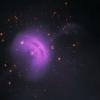Looking at faraway stuff
-
Although the type of star is defined by the heat it's generating, which in turn is a measure of it's mass. Big stars are blue and live relatively short lives, smaller stars are red and burn longer.
-
I guess there is no answer to this question and due to the sheer numbers involved the answer will be yes in theory, but could a earth type planet exist (one where life will evolve) around a gas giant provided that the said gas giant wasn't too far away from the goldilocks zone?
-
I would imagine a planet like that would be very cold due to the amount of time it spends in the shadow of the gas giant.
-
GooberTheHat wrote:I would imagine a planet like that would be very cold due to the amount of time it spends in the shadow of the gas giant.
But if the said planet had a active core / generating its own heat. Plus the gravity effects from the gas giant, surely that would cause enough activity internally no?
-
Dinostar77 wrote:I guess there is no answer to this question and due to the sheer numbers involved the answer will be yes in theory, but could a earth type planet exist (one where life will evolve) around a gas giant provided that the said gas giant wasn't too far away from the goldilocks zone?
Well that would be a moon, and the moons of our own solar system are currently candidates for life. -
SpaceGazelle wrote:
Yeh, I know that. Even Pluto is now though to have water under its dense ice sheets. Maybe I didn't explain properly, I meant earth type as in running liquid water on the surface. Kepler has found some very strange solar systems in its search so far.
-
Of course it's possible. Binary/multiple systems, gravitational compression, fast orbital speed. Might be relatively rare but that means fuck all in a place as big as this.
-
Space is fascinating, I love all the news of new discoveries. Did you catch this story last year? http://earthsky.org/space/why-are-these-black-hole-jets-aligned
-
Consuming space media keeps me sane sometimes.
-
It gives me perspective. No matter how much shit there is going on in life. You take a step back and think about our place in the universe and realise it does'nt mean a thing at all. Nada.
-
Perhaps it's your life that's important and the universe doesn't mean a fucking thing...Dinostar77 wrote:It gives me perspective. No matter how much shit there is going on in life. You take a step back and think about our place in the universe and realise it does'nt mean a thing at all. Nada.
Come with g if you want to live... -
Dinostar77 wrote:Space is fascinating, I love all the news of new discoveries. Did you catch this story last year? http://earthsky.org/space/why-are-these-black-hole-jets-aligned
I reckon it happened a bit like this.
-
g.man wrote:
Perhaps it's your life that's important and the universe doesn't mean a fucking thing...Dinostar77 wrote:It gives me perspective. No matter how much shit there is going on in life. You take a step back and think about our place in the universe and realise it does'nt mean a thing at all. Nada.
Maybe it's both...iosGameCentre:T3hDaddy;
XBL: MistaTeaTime -
When I was young, someone told me that the interior of the Earth and sun were younger than their surfaces. Blew my mind... then did a physics degree.
-
Dinostar77 wrote:I guess there is no answer to this question and due to the sheer numbers involved the answer will be yes in theory, but could a earth type planet exist (one where life will evolve) around a gas giant provided that the said gas giant wasn't too far away from the goldilocks zone?GooberTheHat wrote:I would imagine a planet like that would be very cold due to the amount of time it spends in the shadow of the gas giant.
There's no reason it couldn't orbit the planet across the poles and if it had it's own spin as well could spend an equal amount of time in light and dark"I spent years thinking Yorke was legit Downs-ish disabled and could only achieve lucidity through song" - Mr B -
If it had an atmosphere it probably wouldn't if it was in the shadow for parts of its orbit that much. Also, there's a large area around Jupiter where it's magnetic field protects its moons from cosmic and solar radiation. This kind of protection could be extremely valuable for life around small k or m type stars where the goldilocks zone is like swathed in radiation from the star.
Given how close the goldilocks zone is to the central star in these systems, I wonder if moon orbits would be stable? -
voices wrote:If it had an atmosphere it probably wouldn't if it was in the shadow for parts of its orbit that much. Also, there's a large area around Jupiter where it's magnetic field protects its moons from cosmic and solar radiation. This kind of protection could be extremely valuable for life around small k or m type stars where the goldilocks zone is like swathed in radiation from the star. Given how close the goldilocks zone is to the central star in these systems, I wonder if moon orbits would be stable?
It seems to be a low mass system though, so I wonder if there would be many moons at all of a decent size (Moon, Titan, Galilean moons for example). Perhaps the majority of rocky material became bound to these planets as they formed?"Sometimes it's better to light a flamethrower than curse the darkness." ― Terry Pratchett -
Oh right - I wasn't talking about this new 7 earth system, just places in general where life might be.
-
Ahh sure, my mistake.
I dont know if we know yet. A lot of these close-to-the-star systems are racing through so aren't they going to be high mass/rapid planet formation systems? I wonder if they would even have time to form rocky moons. That said I have very limited knowledge of planet formation so who knows.
We're really just at the cusp of getting an idea of how common rocky planets are. Do they take longer to form than gas giants?
The other risk for life on moons around gas giants is the magnetic field. Whilst that field can protect life on earth, the field around jupiter for example is very hostile to electronics and earth-grown life. I wonder what the habitable range is for complex life in terms of magnetic fields in general?"Sometimes it's better to light a flamethrower than curse the darkness." ― Terry Pratchett -
We are up to 3,500 planets now detected, of various types. It would be amazing if in the next 20-40 years we could detect water / methane or other chemicals which would give us a greater indication of a chance of life on extra solar planets.
Vela wrote:I wonder what the habitable range is for complex life in terms of magnetic fields in general?
I'd have thought without a strong magnetic field, life would struggle to evolve with all the radiation that was no longer being deflected away. It would be interesting as your question said, what that range would be. -
I guess we can have a squiz with the Jovian moons like Europa and possibly some others as well. But as that's a sample size of one, it either has something complex or not. Cant wait to see either way."Sometimes it's better to light a flamethrower than curse the darkness." ― Terry Pratchett
-
The James Webb goes up next year which should be pretty special. Can't wait.
-
SpaceGazelle wrote:The James Webb goes up next year which should be pretty special. Can't wait.
SKA isnt far off either. Its not designed for imaging planets but it'd be hilarious if it found a strong radio signal aligned with a small planet."Sometimes it's better to light a flamethrower than curse the darkness." ― Terry Pratchett -
https://www.wired.com/2017/01/mystery-fast-radio-bursts-gets-beautiful/
We are getting closer to figuring out whats causing it.
Also still no explanation for whats causing the ongoing dimming of KIC 8462852 (Tabby star).
https://astronomynow.com/2016/10/27/breakthrough-listen-to-search-for-intelligent-life-around-weird-star/ -
We should take bets on what is causing that.
Possible candidates I've heard include (some of these probably ruled out)
* Dyson swarm/sphere/other megastructure
* Comet swarm or similar
* Scattered planetary debris
* Something intrinsic to the star itself or atypical behaviour
* Intervening material in the ISM
* Instrument or imaging software failure
My guess is that its probably something intrinsic to the star itself. Maybe there might be clues in neighbouring stars as to what composition it could have assuming it is still in the vicinity of where it formed. Of course that will be something that can be tested via spectroscopy I would imagine. No doubt already done.
Maybe it ate a hot Jupiter?"Sometimes it's better to light a flamethrower than curse the darkness." ― Terry Pratchett -
The light has been diminishing over a period of 100 years. They went back through some archives at Harvard in regards to that patch of sky and found that it has dropping since he early 1900s. I will try to find the original article for the Harvard thing.
Found one:
https://www.google.co.uk/amp/s/www.theatlantic.com/amp/article/482397/
A snippet of the article
"In October 2015, shortly after the alien megastructure hypothesis went public, Bradley Schaefer, an astronomer specializing in careful stellar brightness measurements, decided to look for previous episodes of odd behavior by examining a historical astronomical treasure: photographs of the sky stored in the plate stacks at the Harvard Astronomical Plate Collection in Cambridge, Massachusetts.
For about 100 years, small telescopes have imaged the entire sky, bit by bit, on photographic plates. These plates are now carefully archived and stored by curators at the Harvard-Smithsonian Center for Astrophysics. The center has slowly digitized and made the plates available to the public through a program known as Digital Access to a Sky Century @ Harvard (DASCH).
Schaefer constructed a historical record of Boyajian’s star using online DASCH data. While Schaefer found no evidence of obvious prior eclipse events, the DASCH data did seem to show that the star had slowly dimmed by nearly 20 percent over the past 100 years".
Howdy, Stranger!
It looks like you're new here. If you want to get involved, click one of these buttons!
Categories
- All Discussions2,715
- Games1,879
- Off topic836







